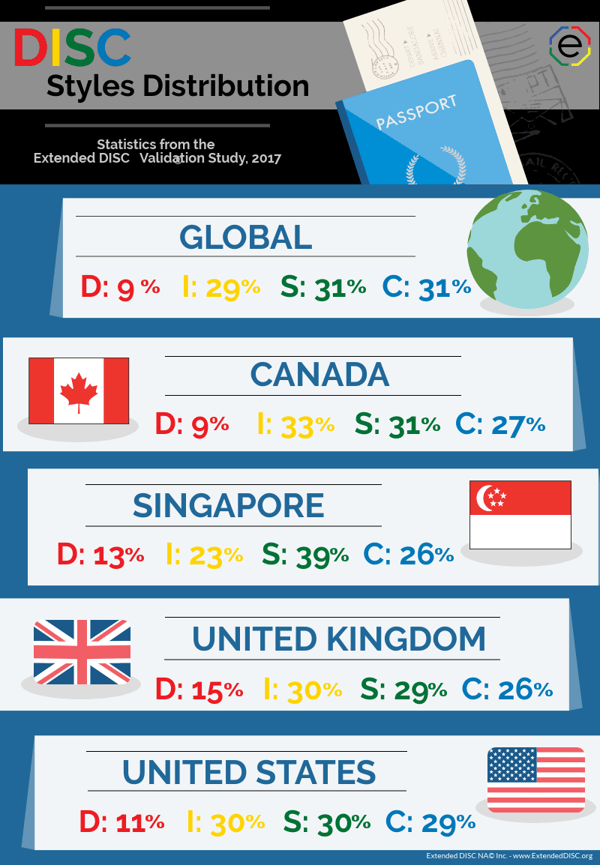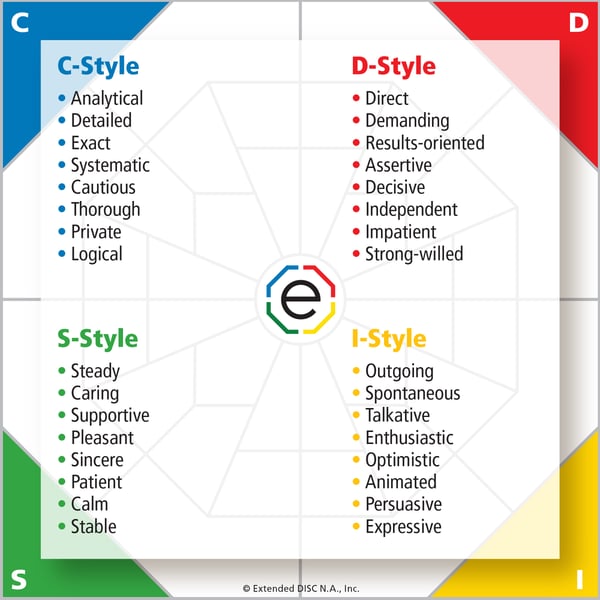Would you be able to recognize a DISC style, whether you're in Singapore, the UK, Canada, or the US?
 What does a D-style look like in Singapore versus a D-style in Canada? Do all D-styles act the same way regardless of where we live? Could we easily recognize two D-styles in a crowd by observing their behaviors? Why does the UK have more D-styles than the global average? We have questions, but the first step is to clarify what DISC is.
What does a D-style look like in Singapore versus a D-style in Canada? Do all D-styles act the same way regardless of where we live? Could we easily recognize two D-styles in a crowd by observing their behaviors? Why does the UK have more D-styles than the global average? We have questions, but the first step is to clarify what DISC is.
What is DISC?

DISC measures our most comfortable behaviors or how we naturally prefer to do things. It does not judge our behaviors as right or wrong, or good or bad. There are no styles that are better or worse. Each of the four DISC styles simply has similarities and differences, and strengths and development areas. The DISC Model divides people into four main behavioral styles which we identify as D-style (Dominance), I-style (Influence), S-style (Steadiness), and C-style (Correctness).
Now, back to the question of DISC, countries, and cultures. We know there has to be some linkage between DISC and cultures, but it may not be as clear as we'd like. Does our country location or cultural background impact our DISC results? Are the behaviors that we observe in all D-styles recognizable and the same? We can now focus on what the DISC tool measures.
The basics of measuring DISC

Keep in mind, we are only addressing Extended DISC® assessments because not all DISC tools measure the same thing. At a basic level, the tool measures how often we self-identify with a style. Our natural style is based on a recognizable pattern of responses to our answer choices. The Extended DISC® System uses the data from our responses to create our profile.
Essentially, it calculates how often we select answers correlating to one style over the other three styles. Are we able to select at least one style in a clear identifiable pattern? If so, the system generates a valid profile. On the other hand, an invalid result occurs when our answer choices do not consistently identify at least one style.
We are measuring our hard-wired behavioral style. We focus on behaviors because we can make successful adjustments to them in our daily interactions. The tool does not factor in where we live, how old we are, or gender to generate results. It does not identify if we are salespeople, leaders, students, or bank tellers. It does not rank us as better or worse.
The process of collecting data is purely based on statistics and thus, culture-free. The results of a D-style in Canada is the same as for a D-style in Singapore; both consistently selected the D-style responses in their answer choices. In summary, the Extended DISC® Tool is a non-judgmental, statistical analysis.
Diving deeper into the DISC tool

We need to ensure the validity of the tool; can we trust the results? The tool, at a deeper level, is designed to find out how the person compares to other people within the same culture. The tool focuses on accurate terminology to elicit specific responses for preferred styles. It cannot be effective if it only has direct translations of similar words.
We ask our clients to take the questionnaire in their most comfortable native language, even if they are multilingual, because it increases the strength of the results. The key to trustworthy profile results is by phrasing questions that cause the preferred style of a person to react accordingly.
DISC and Cultures
 The person's profile is generated from the collected questionnaire data. The profile results can be then be applied to specific styles and content. The reporting style may include sales professional, leadership, and team assessments. In order for us to be able to interpret the data accurately, we need to have an understanding of DISC; specifically, in the context where the information is applied. This part is culture-bound and thus, requires an understanding of the culture.
The person's profile is generated from the collected questionnaire data. The profile results can be then be applied to specific styles and content. The reporting style may include sales professional, leadership, and team assessments. In order for us to be able to interpret the data accurately, we need to have an understanding of DISC; specifically, in the context where the information is applied. This part is culture-bound and thus, requires an understanding of the culture.
We don't need to know exactly how the data is produced, but we need to understand that the tool is based on the DISC Model. We also need to understand the environment where the results are being applied. The question is, "does a DISC style act the same way regardless of the country they are from?" For example, if someone is identified as a D-profile, will we observe the same behaviors in the US as in Singapore?
How to identify D-styles in different cultures
Technically, both the Singaporean and the US citizens are D-styles because both chose the D-style responses in the DISC questionnaire with a strong level of consistency. However, do we witness the same behaviors in the two D-styles? How do they stand out from the other DISC styles in the same country? If you took the D-style from the US and put them in Singapore, would we be able to recognize the person as a D-style? This is something the tool cannot clearly determine because the behaviors we observe in each person is tied to their culture. For example, if you're trying to identify a D-style in a culture that is more aggressive, it may not be as easy.
The DISC results only indicate that, in the US, compared to the other Americans, this person self-identified as D-style. Let's describe D-style as being demanding, assertive, and direct based on their natural behavioral descriptors. This may differ even from regions of the US. What may be considered assertive in New York City, New York may be quite different than being assertive in Honolulu, Hawaii. It is then up to those who understand the culture of the US to determine what exactly D-style means and how D-style behaviors are identified.
Why does the UK have more D-styles than the global average?
Are we surprised that Canadians are predominantly more of the people-oriented styles? The Extended DISC Validation Study* simply presents the demographic data collected, but we do not do any in-depth analysis of the data. It is up to us to make educated guesses on the higher than average percentage of D-styles in the UK and Singapore than the global average.
 to learn more about the Extended DISC tools and Validation Study.
to learn more about the Extended DISC tools and Validation Study.
